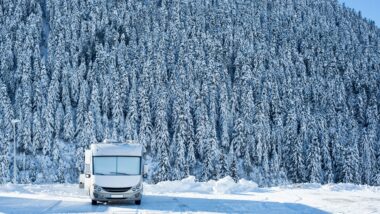Table of Contents Show
Alaska has a reputation for many things, including sled dog races, massive landscapes, and fishing. Additionally, tourists travel thousands of miles each year to test their luck at catching salmon. With five types of salmon in Alaska, many can reel one in.
If you’ve dreamed of taking one of these trips, you’ll want to familiarize yourself with each species. How do you catch them? What do they taste like? These are all essential questions you need to answer.
Luckily, we have your back. Let’s dive into these frozen waters and look at the types of salmon swimming in Alaska.
What Are Alaskan Salmon?
Five types of salmon are native to Alaska. One unique characteristic of these fish is that they’re anadromous. They’re born in freshwater, mature in the ocean, and return to spawn in the same waters of their birth. In addition to playing a significant role in their economy, salmon are a massive part of Alaskan culture.
The species has been a traditional food source and a dietary staple for indigenous communities for centuries. Some indigenous cultures celebrate annual salmon runs through rituals, dances, and ceremonies. You’ll frequently see them depicted in art, crafts, and stories.
What Is the Most Expensive Salmon in Alaska?
Chinook salmon, often called king salmon, is Alaska’s largest and most expensive type of salmon. Prices typically change based on the market and harvest, but Chinook salmon generally costs $30 to $70 per pound.
It won’t be cheap if you’d like to buy an entire fish. Since these fish can weigh 30 to 100 pounds, a whole fish could cost you $900 to $7,000. You better come with a fat stack of cash if you plan to buy!
When and Where is the Best Time to Fish Salmon in Alaska?
Because of the intense winters, the best time to fish in Alaska is during the warmer months. Plan your trip between May and September, no matter what type of salmon you plan to catch.
However, if you want to catch a specific type of salmon, you’ll want to check the regulations in Alaska. Luckily, if you’re using guide services, they’ll help ensure you stay on the right side of the law.
Again, another advantage of using a guided service is that they can help ensure you fish in the best spots. The best areas are rivers, streams, and other Alaskan waters. Kenai River, Bristol Bay, Copper River, and the Southeast Alaska waters provide fantastic fishing. Many anglers leave these waters with plenty of fish and memories they’ll never forget.

The Five Types of Salmon in Alaska
So what are the differences between the five types of salmon in Alaska? Let’s look at each species and which ones you want to try to catch.
Pink Salmon
Pink salmon have a two-year life cycle and are prominent through rivers and streams in Alaska. They often get nicknamed “humpies” because the males develop a hump while spawning. Their spawning season occurs in odd-numbered years from mid-July to early September.
They’re the smallest salmon species in Alaska and have silver bodies and sides with a touch of pink. To add to their fascinating appearance, the males develop a hook-like jaw.
In terms of commercial fishing, these are often canned. You’ll often find them used in various products that involve processed salmon. However, it keeps its delicious flavor.
Keep in Mind: There are plenty of opportunities to fish in Alaska! But what fishing license do you need? Click to find out!
Chinook Salmon
As we mentioned, Chinook salmon, also known as king salmon, are the largest species of salmon. They have a richer flavor but are also very fatty. Hooking into one of these massive fish will be an unforgettable experience. However, landing one of these fish is no easy task, as they put up a substantial fight.
The salmon run for Chinook typically occurs from May to early July. It marks the start of the fishing season throughout the state. You’ll see people worldwide converging on the Kenai and Kasilof Rivers, trying to catch the next record-breaking salmon.

Coho Salmon
If you spot a salmon with silver sides, there’s a good chance it’s Coho salmon. The Coho salmon run typically occurs between July and September.
Many anglers enjoy battling this type of Alaska salmon because they leap into the air and put up a solid fight. You’ll normally find them in Bristol Bay, the Kenai River, and throughout the Copper River.
When it comes to taste, Coho salmon is a popular choice. This is primarily because they have a milder flavor than the other species of salmon. Like Goldilocks, many find the Coho salmon to be just right.
Keep in Mind: Whittier, Alaska, is a quirky town, but we loved our visit! See why Whittier is worth a visit.
Sockeye Salmon
Want to catch a Sockeye? The best time to catch one of these unique species is in late June to early August. Like a chameleon, Sockeye salmon can drastically change colors. They start as a silver color and quickly change into a fiery red color. The color transitions typically indicate they’re ready to reproduce.
They have a vibrant flavor and bright-colored flesh. They’re best enjoyed grilled, baked, or smoked. If you’re a sushi fan, this is the salmon typically used for these dishes. However, it’s delicious, no matter how you prepare it.

Chum Salmon
The last type of salmon in Alaska is the Chum salmon, also called dog salmon. They are best caught from July to September. They receive this nickname because males develop canine-like teeth while spawning. They’re typically easy to find in the Yukon River, Kuskokwim River, and Norton Sound.
They may not have the allure of king and some more popular salmon, but they’re still worth catching. This is a firmer meat with a mild flavor. You can smoke, grill, or bake it. This is another popular species used for processed salmon products. You’ll find them in canned and smoked products processed and shipped worldwide.
How Many Types of Salmon Will You Catch in Alaska?
Fishing in Alaska can be an out-of-this-world experience. You can enjoy some epic views and maybe catch some dinner. Whether fishing in a quiet stream, floating on a river, or out in a bay, it’s hard to beat fishing in Alaska. No matter where you do it, it’ll be an adventure you likely will remember for a while.
Have you fished for salmon in Alaska?






